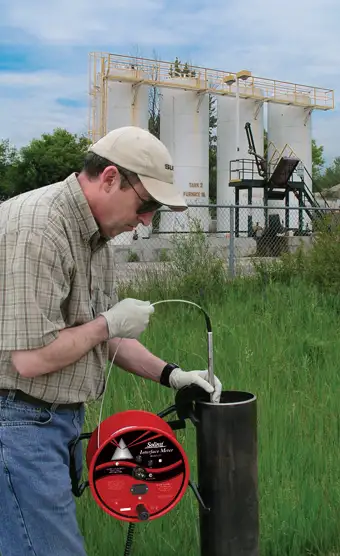
Interface Meter Operating Principles
Product (Non-conductive liquid) = Steady light and tone
Water (Conductive liquid) = Intermittent light and tone
To detect liquids, Solinst Interface Meters use an infra-red beam and detector. When the probe enters a liquid the beam is refracted away from the detector which activates an audible tone and light.
If the liquid is a non-conductive oil/product the signals are steady. If the liquid is conductive (water), the conductivity of the water completes a conductivity circuit. This overrides the infrared circuit, and the tone and light are intermittent.
The 122 Interface Meter sensor provides an accuracy as good as 1.0 mm or 1/200 ft. The high accuracy enables the sensor to detect the slightest sheen of oil on the surface of the water.
High Quality Design
The state-of-the-art electronics include automatic circuitry testing when the ‘On’ button is used; 120 hours of on-time battery life; clear signals; and high accuracy. The circuits are powered by a single standard 9V battery which is housed in an easy-access drawer in the faceplate of the reel.
Infra-red refraction is used to detect liquids and conductivity to distinguish water. Both optical and electronic sensors are precisely aligned at the same zero point. The factory sealed probe does not need to be accessed by the user. An integral stainless steel shield protects the sensors. It is set permanently into place, yet allows for easy cleaning.
Features
- Sensor accuracy to 1.0 mm or 1/200 ft
- Certified intrinsically safe
- 16 mm (5/8") diameter probe
- Easy access 9V battery
- Automatic shut off after 5 minutes
- Replacement tapes are interchangeable with other Meters
Model 122 & 122M are CSA approved for use in hazardous |



